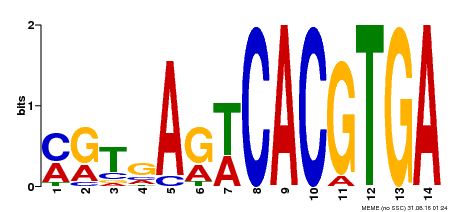- Riechmann JL, et al.
Arabidopsis transcription factors: genome-wide comparative analysis among eukaryotes.
Science, 2000. 290(5499): p. 2105-10
[PMID:11118137] - Heim MA, et al.
The basic helix-loop-helix transcription factor family in plants: a genome-wide study of protein structure and functional diversity.
Mol. Biol. Evol., 2003. 20(5): p. 735-47
[PMID:12679534] - Toledo-Ortiz G,Huq E,Quail PH
The Arabidopsis basic/helix-loop-helix transcription factor family.
Plant Cell, 2003. 15(8): p. 1749-70
[PMID:12897250] - Bailey PC, et al.
Update on the basic helix-loop-helix transcription factor gene family in Arabidopsis thaliana.
Plant Cell, 2003. 15(11): p. 2497-502
[PMID:14600211] - Bauer P, et al.
Analysis of sequence, map position, and gene expression reveals conserved essential genes for iron uptake in Arabidopsis and tomato.
Plant Physiol., 2004. 136(4): p. 4169-83
[PMID:15531708] - Zhang W, et al.
Regulation of Arabidopsis tapetum development and function by DYSFUNCTIONAL TAPETUM1 (DYT1) encoding a putative bHLH transcription factor.
Development, 2006. 133(16): p. 3085-95
[PMID:16831835] - Li N, et al.
The rice tapetum degeneration retardation gene is required for tapetum degradation and anther development.
Plant Cell, 2006. 18(11): p. 2999-3014
[PMID:17138695] - Tang C, et al.
The evolution of selfing in Arabidopsis thaliana.
Science, 2007. 317(5841): p. 1070-2
[PMID:17656687] - Wijeratne AJ, et al.
Differential gene expression in Arabidopsis wild-type and mutant anthers: insights into anther cell differentiation and regulatory networks.
Plant J., 2007. 52(1): p. 14-29
[PMID:17666023] - Xing S,Zachgo S
ROXY1 and ROXY2, two Arabidopsis glutaredoxin genes, are required for anther development.
Plant J., 2008. 53(5): p. 790-801
[PMID:18036205] - Zhu J, et al.
Defective in Tapetal development and function 1 is essential for anther development and tapetal function for microspore maturation in Arabidopsis.
Plant J., 2008. 55(2): p. 266-77
[PMID:18397379] - Xu J, et al.
The ABORTED MICROSPORES regulatory network is required for postmeiotic male reproductive development in Arabidopsis thaliana.
Plant Cell, 2010. 22(1): p. 91-107
[PMID:20118226] - Skinner MK,Rawls A,Wilson-Rawls J,Roalson EH
Basic helix-loop-helix transcription factor gene family phylogenetics and nomenclature.
Differentiation, 2010. 80(1): p. 1-8
[PMID:20219281] - Zhu J,Lou Y,Xu X,Yang ZN
A genetic pathway for tapetum development and function in Arabidopsis.
J Integr Plant Biol, 2011. 53(11): p. 892-900
[PMID:21957980] - Wang XT,Yuan C,Yuan TT,Cui SJ
The Arabidopsis LFR gene is required for the formation of anther cell layers and normal expression of key regulatory genes.
Mol Plant, 2012. 5(5): p. 993-1000
[PMID:22461668] - Feng B, et al.
Regulation of the Arabidopsis anther transcriptome by DYT1 for pollen development.
Plant J., 2012. 72(4): p. 612-24
[PMID:22775442] - Jiang J,Zhang Z,Cao J
Pollen wall development: the associated enzymes and metabolic pathways.
Plant Biol (Stuttg), 2013. 15(2): p. 249-63
[PMID:23252839] - Gu JN, et al.
DYT1 directly regulates the expression of TDF1 for tapetum development and pollen wall formation in Arabidopsis.
Plant J., 2014. 80(6): p. 1005-13
[PMID:25284309] - Qian H, et al.
Trace concentrations of imazethapyr (IM) affect floral organs development and reproduction in Arabidopsis thaliana: IM-induced inhibition of key genes regulating anther and pollen biosynthesis.
Ecotoxicology, 2015. 24(1): p. 163-71
[PMID:25348600] - Jin J, et al.
An Arabidopsis Transcriptional Regulatory Map Reveals Distinct Functional and Evolutionary Features of Novel Transcription Factors.
Mol. Biol. Evol., 2015. 32(7): p. 1767-73
[PMID:25750178] - Shumin Z, et al.
One novel cis-element is essential for correct DYSFUNCTIONAL TAPETUM 1 (DYT1) expression in Arabidopsis thaliana.
Plant Cell Rep., 2015. 34(10): p. 1773-80
[PMID:26134855] - Zhu E, et al.
The DYT1-interacting proteins bHLH010, bHLH089 and bHLH091 are redundantly required for Arabidopsis anther development and transcriptome.
Plant J., 2015. 83(6): p. 976-90
[PMID:26216374] - Cui J, et al.
Feedback Regulation of DYT1 by Interactions with Downstream bHLH Factors Promotes DYT1 Nuclear Localization and Anther Development.
Plant Cell, 2016. 28(5): p. 1078-93
[PMID:27113773] - Arkadir D, et al.
DYT1 dystonia increases risk taking in humans.
Elife, 2017.
[PMID:27249418] - Premi E, et al.
Functional Connectivity Networks in Asymptomatic and Symptomatic DYT1 Carriers.
Mov. Disord., 2016. 31(11): p. 1739-1743
[PMID:27453152] - Beauvais G, et al.
Disruption of Protein Processing in the Endoplasmic Reticulum of DYT1 Knock-in Mice Implicates Novel Pathways in Dystonia Pathogenesis.
J. Neurosci., 2016. 36(40): p. 10245-10256
[PMID:27707963] - Richter F,Gerstenberger J,Bauer A,Liang CC,Richter A
Sensorimotor tests unmask a phenotype in the DYT1 knock-in mouse model of dystonia.
Behav. Brain Res., 2017. 317: p. 536-541
[PMID:27769743] - Zhou S, et al.
Function Identification of the Nucleotides in Key cis-Element of DYSFUNCTIONAL TAPETUM1 (DYT1) Promoter.
Front Plant Sci, 2017. 8: p. 153
[PMID:28261229] - Li DD,Xue JS,Zhu J,Yang ZN
Gene Regulatory Network for Tapetum Development in Arabidopsis thaliana.
Front Plant Sci, 2017. 8: p. 1559
[PMID:28955355] - Ponterio G, et al.
Enhanced mu opioid receptor-dependent opioidergic modulation of striatal cholinergic transmission in DYT1 dystonia.
Mov. Disord., 2018. 33(2): p. 310-320
[PMID:29150865] - György B, et al.
Mutant torsinA in the heterozygous DYT1 state compromises HSV propagation in infected neurons and fibroblasts.
Sci Rep, 2018. 8(1): p. 2324
[PMID:29396398]
|





